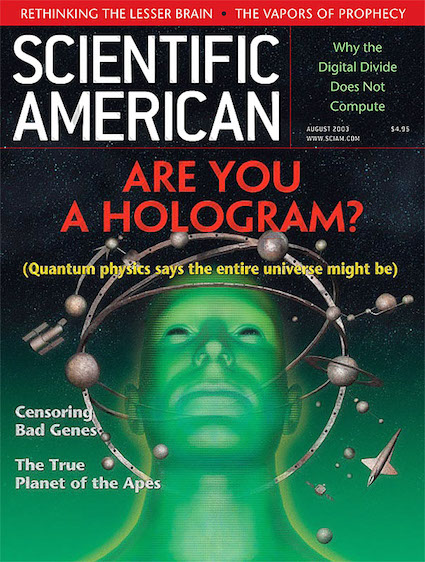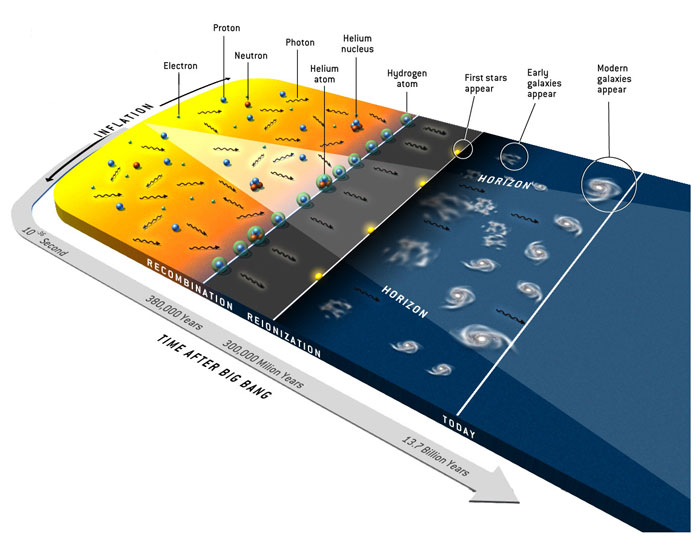Is the Universe we know the right one?
##Simulation of the universe A quantum computer can compute in an extremely faster way than a classical computer; and is able to simulate the laws of nature, the laws of physics. The quantum simulation is the process on which a quantum computer simulates another quantum computer. The result is so accurate that the simulation is in fact indistinguishable from the simulated system. The two systems are logically equivalent. How a digital computer differ from an analog computer?
A classic analog computer manipulates contiguous variables, like a voltage. This is because of classic variables (e.g. velocity, volume or pressure) are contiguous, so to simulate them the computer has to be contiguous itself. A digital computer comes with discrete quantities, as the bits are discrete. A digital computer can handle continuous variables, but only after a discretization process. In a quantum computer, however, there is no distinction between analogy and digital computation. Quanta are discrete by definition, and their status can be directly mapped in the state of qubits without error of approximation. But the qubits are also continuous, because of their wave nature; their states can be an overlap continues. It follows that in a quantum computer, this distinction has no more reason to exist; no longer makes sense to speak of analog or digital.

######Are you a Hologram? (Credit: Scientific American)
##Simulation and reality The question on the difference between simulation and reality has ancient origins. For instance, consider the Tao Te Ching, an ancient Chinese text written around 6th century BC by the sage Laozi (or Lao Tzu).
The book is susceptible to 10000 interpretations. It starts with this quite ambiguous sentence:
The way can be Followed That is not the true way.
The Name That can be named is not the true name.
Laozi seems to suggest that by assigning a name to things, we introduce an artificial distinction that fails to capture entirety the Universe below. Let’s apply the Tao Te Ching to quantum mechanics. A quantum computer that simulates the universe will have exactly the same numbers of qubits that are in the Universe, and the operations of these qubits exactly simulate the dynamics of the Universe. This computer will be as Laplace’s demon, since he knows everything about the Universe, there are no mysteries for him. Such quantum computation constitutes a complete description of the nature, and therefore indistinguishable from the nature itself.
So in conclusion, the Universe can be thought of as if he is actually performing a quantum computation, and saw that the particles can be mapped directly into qubits that perform logic operations, a simulation of the Universe on a quantum computer is indistinguishable from the Universe itself. In conclusion, since the Universe registers and processes information as a quantum computer and its observability is indistinguishable from a quantum computer, then it must actually be a quantum computer.
The information is physical. The information processing is physical too. Once you know the quantum mechanics and quantum computing, it’s surprisingly easy to determine how much a physical system can perform computations. Where electrons can be, and how they move from one place to another, is governed by the laws of physics. Recall the laws of physics determine how much information a particular physical system can record and how quickly that information can be recorded.
##Physical Limits to Computation Suppose that all the matter and energy present in our Universe is available for computing. How powerful could be the final computer?
As first thing, recall that energy limits the speed. The amount of energy in the Universe has been determined with a high degree of accuracy. We know that much of it is confined in the mass of the electrons. However, the density of the Universe is not particularly high: about one hydrogen atom per cubic meter.
Consider that when we affirm let’s calculate the computational capacity of the Universe, what we are really doing is calculating the computational capacity of the Universe in the horizon, that is, when the Universe was born (about 14 billion years ago). Beyond the horizon, we can only guess what happened or will happen. As time passes, the horizon of the Universe is expanding at a rate that is three times the speed of light.

######Timeline of the Universe (Credit: background.uchicago.edu)
Looking through a telescope we look in the past. As the horizon expands, more and more objects come in the visible range, and the amount of energy available for computation within the horizon increases. The horizon is 42 billion light years away.
In the Universe there are about 1071 Joules of energy. A computer made by all the energy of the Universe can make 10105 operations per second, more than 100 000 googol!. The cosmological computer can perform 10122 operations per second on 1092 bits.
The laws of physics dictate a fundamental limit on the speed of computation and the number of bits available. The computational speed is limited by the energy available, and the number of bits is limited by this energy and the size of the system that performs the computation. The computational power grows with time, because the horizon is expanding very quickly. Modern physics is based on the mechanistic model. In this paradigm, the main quantity is the energy. Think about the world not only as a machine but as a machine that processes information. In this paradigm, there are two primary quantities: energy and information.
They are on the same plane, and play a role with one another. It allows us to give new insight into the workings of the Universe.
First insight: think of the Universe in terms of information leads to the resolution of the problem of complexity, because of the nature is so complex.
Second insight: inquiries concerning the application on the shape of the universe in the earliest stages. In particular, quantum computation is a possible way to the quantum gravity.
The theory of general relativity takes account for the objects at very large scales. Quantum mechanics, however, takes into account the objects to atomic scales. But to give a complete view of the Universe. when it was still small and incredibly energetic, requires a theory that can unify general relativity and quantum mechanics, two theories that are undeniably useful monumental correct but that are fundamentally incompatible to the base.
##Quantum computing and quantum gravity To build a theory of quantum gravity by quantum computing, is necessary to show the way quantum computation includes the concept of space and time. The theory must be able to forecast, as well as must be able to demonstrate results already observed. General Relativity Theory is a theory of space, time and their interactions with matter. All possible configurations of space and time interacting with matter is called space-time.Our Universe is nothing but a particular space-time.
What happens to information in quantum computation is independent from the way quantum computing is built in space-time. The fact that quantum computation does not take into account how it is included into space-time, it means that space-time derived from quantum computing obeys the laws of general relativity. Why all this? Because of Einstein derived his laws of General Relativity requiring that these laws do not take account of how the dynamics underlying physics of matter were incorporated into space-time. Einstein’s equations relate the geometry of the space-time behavior and the matter in it. Geometry tells matter where to go, and matter tells geometry how to curve.
###Further Information
Programming the Universe, by Seth Lloyd
Ultimate physical limits to computation, by Seth Lloyd
The Universe as Quantum Computer, by Seth Lloyd
Quantum Computing, Wikipedia.org
The Road to Reality: A Complete Guide to the Laws of the Universe, by Roger Penrose
Dance of the Photons: From Einstein to Quantum Teleportation
General relativity, Wikipedia.org